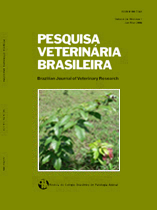 |
|
|
|
Year 2009 - Volume 29, Number 07
|

|
Aspectos clínicos-hematológicos e lesões vesicais nas formas crônicas de intoxicação espontânea por Pteridium aquilinum em bovinos, p.515-525
|
ABSTRACT.- Gabriel A.L., Kommers G.D., Masuda E.K, Fighera R.A., Piazer J.V.M., Barros C.S.L., Martins T.B. & Rosa F.B. 2009. [Clinical and hematological aspects and urinary bladder lesions in chronic spontaneous poisoning by Pteridium aquilinum in cattle.] Aspectos clínicos-hematológicos e lesões vesicais nas formas crônicas de intoxicação espontânea por Pteridium aquilinum em bovinos. Pesquisa Veterinária Brasileira 29(7):515-525. Departamento de Patologia, Universidade Federal de Santa Maria, Camobi, Santa Maria, RS 97105-900, Brazil. E-mail: glaukommers@yahoo.com
Spontaneous cases of chronic poisoning by Pteridium aquilinum in cattle were studied. The clinical forms of the disease were squamous cell carcinoma (SCCs) of the upper digestive tract (UDT) and bovine enzootic hematuria (BEH). The cases were from the midland Region of the Midwest of Rio Grande do Sul State, Brazil, and were submitted to the Laboratório de Patologia Veterinária of the Universidade Federal de Santa Maria. Clinical signs and blood work were evaluated at terminal phase of disease. Cattle with UDT SCCs had progressive weigth loss, ruminal atony, cough, dysphagia, bloating, and regurgitation. In cattle with BEH, hematuria was observed in all cases, followed by progressive weight loss. Non-regenerative anemia was detected in 33.33% of the cattle with UDT SCCs form and in 66.66% of the cattle with BEH form. Changes in white blood count occurred in some cases but drop in lymphocyte numbers was uncommon in both forms of disease. For the morphological study, urinary bladders from 46 cattle with UDT SCCs and 11 cattle with BEH were analyzed. Grossly, 16/46 bladders from the UDT SCCs form had gross lesions (red or pale vesical nodules, hemorrhages, and papilomas; red urine was detected at necropsy of only three cases). In BEH form, the bladder had nodules, large neoplastic masses, red urine, papilomas, and hemorrhages. Pyelonephritis and hydronephrosis were seen in a few cases. Microscopically, in the UDT SCCs form, 44/46 (95.65%) bladders had 22 different types of morphological changes, characterized by neoplastic lesions (5/22) and non-neoplastic lesions (17/22); the latter were subdivided in non-neoplastic epithelial changes (6/17), general changes of the lamina propria (6/17), and inflammatory changes (5/17). The bladder changes in BEH form were of 19 different types, characterized by neoplastic lesions (5/19) and non-neoplastic lesions (14/19), which were subdivided in non-neoplastic epitelial changes (9/14), general changes of the lamina propria (3/14), and inflammatory changes (2/14). In BEH, mesenchymal neoplasms were more observed than epithelial ones, and most of them were malignant. Immunohistochemistry was utilized to characterize the histogenesis of poorly differentiated neoplasms. In conclusion, the morphological study demonstrated that urinary bladder lesions identical to the those seen in cattle with BEH, are very often present in cattle with the UDT SCCs form. |
| |
|
|
| |
|
 |